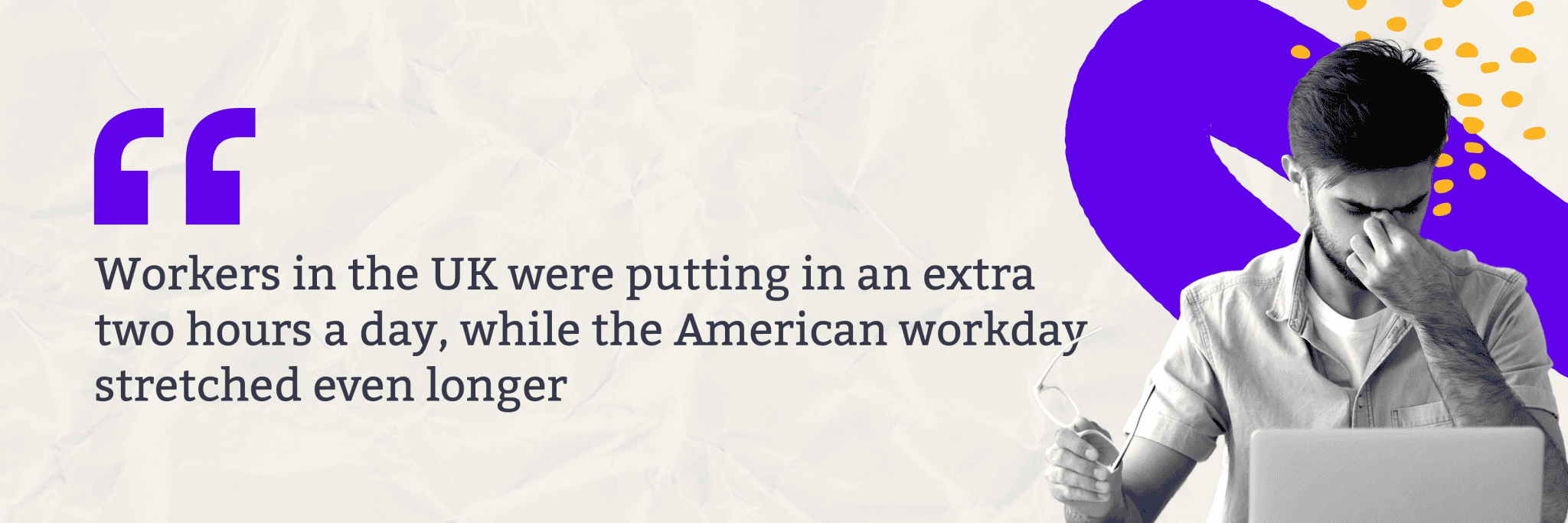Overcoming an ‘Always-on’ Culture to Achieve True Work-Life Balance

Barry Nyhan
Senior Demand Gen & Marketing Ops
3 May 2022

As flexible working becomes ubiquitous, achieving the right work-life balance becomes more important than ever.
The freedom and flexibility provided by remote work come with one prominent downside: an expectation to be ‘always-on’.
Whether they are pursuing a remote, fully in-office or a hybrid work structure, employers can’t afford to ignore this widespread problem, but especially those that want to continue offering flexible work options. In our increasingly remote working environment, it is incumbent on leaders to enforce the appropriate guardrails for keeping work from encroaching too far into their employees’ personal time.
The lines between work and life had already started to blur well before the pandemic and the remote work experiment that followed. In fact, the term ‘work-life balance’ first appeared in the UK in the 1980s, as part of the women’s liberation movement. In those days it was specific to female staff, who were expected to dedicate their time to both their career and their families. It wasn’t until the late 20th century that the term was applied across gender lines, but the concept really took off in the last decade, as new technologies disentangled work responsibilities from their designated time (nine-to-five, Monday-to-Friday) and place (the office).
As with many of society’s underlying problems, the pandemic caused this long-simmering issue to boil over. In the early days of the COVID-19 crisis, amidst a backdrop of work insecurity and concerns over economic collapse, workers felt pressured to put in extra hours. In fact, in early 2021 researchers found that workers in the UK were putting in an extra two hours a day, while the American workday stretched even longer.

Furthermore, according to a recent study conducted by Microsoft, average time spent in meetings each week has gone up 252% over the last two years, while chat volume on MS Teams is up 32%. Even today, as lockdowns are lifted and workers return to the office, they continue to spend 46 more minutes working each day, with after-hours work up 28% and weekend work up 14% in the last year, according to the Microsoft study.
The reasons for this should be obvious to anyone who has worked remotely these past two years. Without direct, in-person oversight, remote workers often feel like they need to prove that they are actually putting in the effort, which causes many to respond to work requests in their off hours.
Without the physical separation between the workplace and the home it’s also harder to get out of work mode as your designated workstation is just a few steps away. Even for those without a home office, mobile technology has put many of the tools that were previously only accessible in that designated workspace into their pockets. The result is more internal pressure to look productive, and less friction logging on to work.
Answering an email on a Sunday or putting in a few extra hours during crunch time often doesn’t have a dramatic effect on its own, but long-lasting imbalances between work and life can have a compounding effect. This became especially prevalent during the early days of the pandemic, when anxiety was already running high. In 2021, the American Psychological Association found that 79% of employees had experienced work-related stress, while a McKinsey & Company study concluded that nearly half of workers around the world experienced some degree of burnout. McKinsey also warns that the figure, high as it is, is likely an undercount.
According to Workvivo’s latest research, 98% of HR professionals have felt burnt out at work in the past 6 months, and 97% have felt emotionally fatigued from work in the last year.
Some national governments even felt the problem was so pronounced that they took it upon themselves to address it. France, Spain, Portugal, and the Canadian province of Ontario have all implemented ‘right to disconnect’ laws, barring employers from penalizing workers for disconnecting from their work during non-working hours. These efforts are a good start, but at the end of the day this shouldn’t be a matter of public policy, but rather one of corporate culture.
Helping your people build a better work-life balance
There are a lot of small steps leaders and managers can take to ensure greater work-life separation, especially in a remote or hybrid setting. The first is establishing a culture of trust; one that provides clear expectations, transparent evaluations and open lines of communication. When managers take the time to clearly outline expectations, deliverables, and how each employee’s efforts will be measured, workers feel less pressure to prove their productivity, so long as they continue to meet those expectations.

Setting policies around time-off minimums and banning after-hours communications is also a positive step, but such policies are only as effective as the examples set by leadership. Taking time off to fully disconnect from work, or being unreachable on weekends, was once considered a sign of weakness, especially among upper management.
Within the context of a global mental health crisis, however, doing so sends a strong and much-needed signal to the rest of the organization. Taking time off themselves, and refraining from engaging their staff on their time off, is paramount. Even an email sent by a manager on a Saturday that clearly says “don’t respond until Monday” is enough to ruin a day off, so it’s always better to schedule those emails to go out during work hours.
If you really want to go the extra mile, enforce breaks between meetings, even when virtual; cut meeting time and frequency as much as possible and ban meetings before noon on Mondays and after noon on Fridays.
The lines between work and life have been blurring for generations, but the pandemic, coupled with the rise of remote communication and collaboration technology, has eliminated many of the barriers that kept the two apart. Now, with the potential for work responsibilities to follow us everywhere we go, it is incumbent on leaders to consider how to best enforce that divide. Those who fail to do so are likely to encounter greater staffing challenges in an already difficult talent landscape.